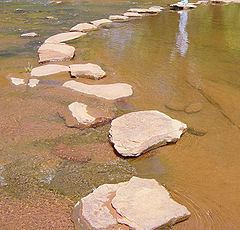Carries Pedestrians Carry Pedestrian | Material Selected stone | |
 | ||
Related Span range Has no spans, but stones must be spaced to allow water flow and a comfortable step or leap Similar | ||
Stepping stones or stepstones are sets of stones arranged to form a simple bridge or causeway that allows a pedestrian to cross a natural watercourse, such as a river; or a water feature in a garden where water is allowed to flow between stone steps. Unlike other bridges, they have no spans. Stepping stones, along with log bridges, are likely to have been the oldest bridge types. They are sometimes built by hikers. They may be impossible to cross when the river level is high. Also, occasionally they may be disarranged by the force of the river when it is flowing unusually powerfully.
Historic stepping stones
The Drukken Steps in the Eglinton Woods of North Ayrshire in Scotland were a favourite haunt of the poet Robert Burns and his companion Richard Brown, whilst the two were living in Irvine from 1781 to 1782.
The name "Drukken" steps derives from a person's gait as they stepped from stone to stone whilst crossing the Red Burn. Seven or more stones were originally set in the Red Burn which was much wider than now (2009).
Burns himself used the Scots spelling "Drucken" rather than "Drukken". The ruins of the Drukken Steps are now found in the Eglinton Country Park.
